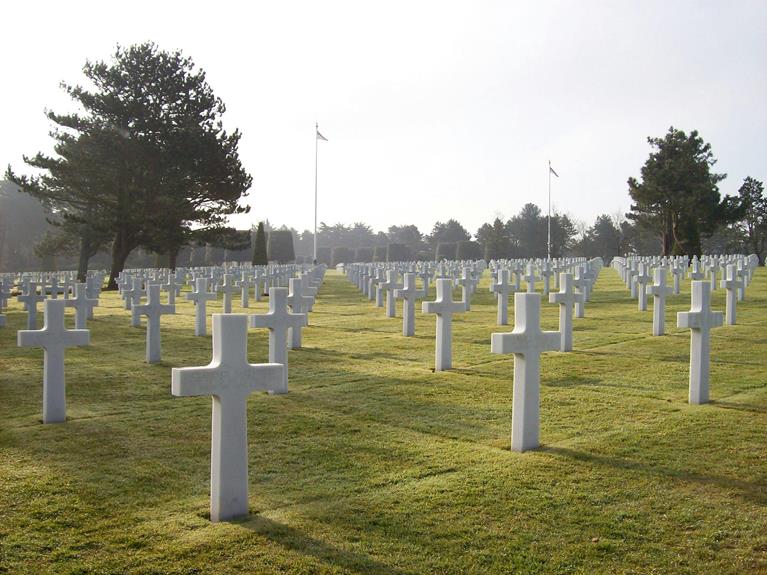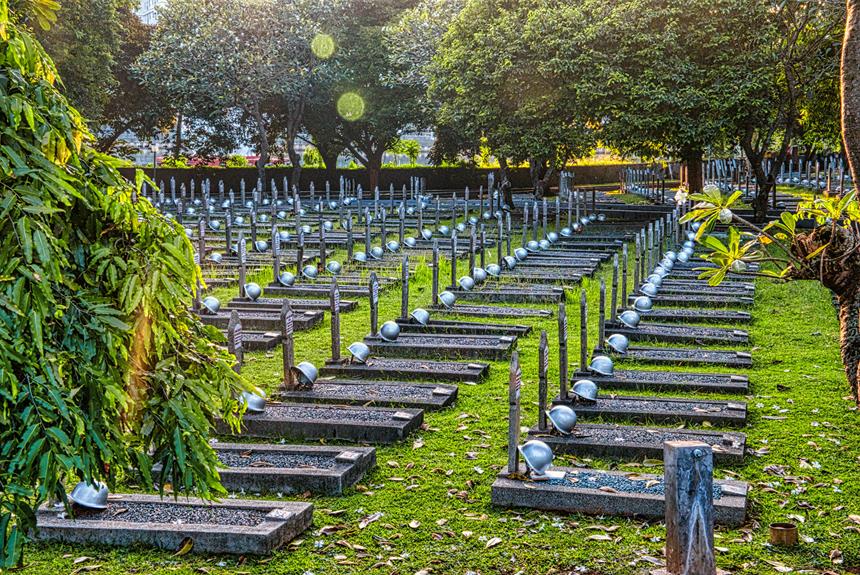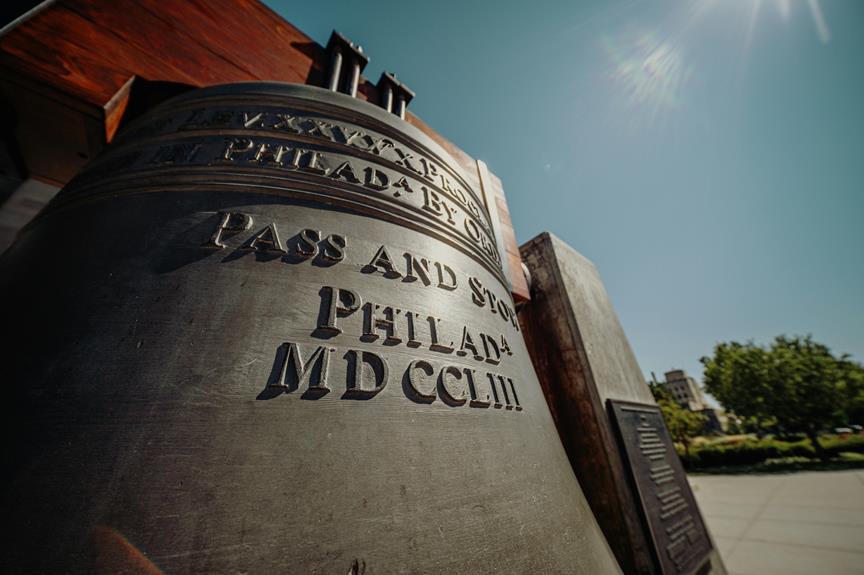The Vietnam Veterans Memorial in the USA, a solemn tribute to those who served during the Vietnam War, has become an enduring symbol of honor and reflection. Its stark design and the sheer number of names etched into its surface evoke a sense of profound loss and sacrifice. Beyond its physical presence, the memorial has sparked deep conversations and emotional responses, drawing visitors from around the world. As a place where history and memory intersect, the Vietnam Veterans Memorial continues to provoke contemplation and serves as a testament to the resilience and spirit of those who have served.
Key Takeaways
- Designed by Maya Lin, a symbol of sacrifice and gratitude.
- Offers a healing journey for visitors, evoking deep emotions.
- Reflects the nation's evolving view of veterans post-Vietnam War.
- Inspires remembrance, unity, and education on war's impact.
- Symbolizes the human cost of war and societal healing.
History and Design of the Memorial
The Vietnam Veterans Memorial in the United States stands as a poignant tribute to the history and design of the memorial, encapsulating the complexities of its creation and the profound impact it has had on visitors. The memorial, commonly referred to as 'The Wall,' was designed by Maya Lin, a 21-year-old architecture student at Yale University. Lin's design details a black granite wall with the names of over 58,000 servicemen and women who lost their lives or went missing during the Vietnam War etched into its surface chronologically.
The construction process of the memorial was not without controversy. Initially, the design faced backlash and skepticism due to its unconventional and minimalist approach. However, as the memorial took shape, its powerful simplicity began to resonate with the public. The construction of the memorial involved meticulous attention to detail to make certain that each name was accurately inscribed, honoring the individual sacrifices made during the conflict.
The design of the Vietnam Veterans Memorial has been praised for its ability to evoke deep emotions and provide a space for reflection and remembrance. The stark contrast of the black granite against the lush greenery of the National Mall creates a somber yet serene atmosphere, inviting visitors to pay their respects to the fallen heroes. The memorial's design and construction process have made it a timeless symbol of honor and reverence for those who served in the Vietnam War.
Significance of the Wall
Eliciting profound reverence and emotional introspection, the Vietnam Veterans Memorial Wall stands as a solemn tribute to the sacrifices made during the Vietnam War. The significance of the Wall lies not only in its historical context but also in its profound emotional impact on visitors, guiding them through a healing process as they pay their respects to the fallen heroes. Here are three key points that highlight the significance of the Wall:
- Emotional Experience: The Wall serves as a powerful symbol of remembrance, evoking a range of emotions in visitors. The sheer scale of the memorial, with its thousands of names etched in black marble, creates a somber atmosphere that allows individuals to connect with the personal stories behind each name. Visitors often experience a deep sense of loss, gratitude, and reflection as they run their fingers over the engraved names, making it a profoundly emotional experience.
- Healing Process: For many veterans, family members, and friends of those who served in the Vietnam War, visiting the Wall can be a cathartic and healing experience. The act of confronting the names of loved ones or comrades who made the ultimate sacrifice can provide a sense of closure and solace. The Wall offers a space for collective mourning and healing, allowing individuals to come to terms with the impact of the war on their lives and the nation as a whole.
- Symbol of Unity and Freedom: Beyond its role as a memorial, the Wall stands as a symbol of unity and freedom, reminding visitors of the values and liberties that the veterans fought to defend. It serves as a poignant reminder of the cost of war and the importance of cherishing the freedoms that have been hard-won through sacrifice and courage. The Wall's significance extends beyond its physical structure, embodying the enduring spirit of resilience and patriotism that defines the American identity.
Impact on Visitors
An exploration of the Vietnam Veterans Memorial Wall reveals the profound impact it has on visitors, both emotionally and psychologically. The stark black granite panels, inscribed with the names of over 58,000 fallen soldiers, evoke a deep emotional connection with those who visit. For many, standing before the Wall is a powerful and somber experience, stirring feelings of sorrow, gratitude, and reflection.
Visitors often find themselves on a healing journey as they trace their fingers over the engraved names, honoring the lives sacrificed during the Vietnam War. The act of locating a specific name, touching it, and perhaps leaving behind a token or a note, can be a cathartic process for individuals seeking closure or solace. The Wall provides a space for collective mourning and remembrance, allowing visitors to grieve together and find comfort in shared experiences.
The impact of the Vietnam Veterans Memorial goes beyond mere symbolism; it serves as a tangible reminder of the human cost of war. The Wall prompts contemplation on the realities of conflict, the sacrifices made by service members, and the enduring legacy of those who never returned home. Through its design and layout, the memorial fosters a sense of unity and shared history among visitors, reinforcing the importance of honoring the past to shape a better future.
Commemorative Events and Ceremonies
Numerous commemorative events and ceremonies held at the Vietnam Veterans Memorial serve as poignant tributes to honor the sacrifices made by those who served during the Vietnam War. These events play an essential role in the healing process for veterans and their families, providing them with a space to come together, share their experiences, and find solace in the camaraderie of fellow service members who understand the impact of war.
Key Aspects of Commemorative Events at the Vietnam Veterans Memorial:
- Healing Process for Veterans: Commemorative events at the memorial offer veterans a platform to confront their past, express their emotions, and begin the healing process from the traumas of war. The act of gathering with others who have shared similar experiences can be cathartic and empowering, fostering a sense of understanding and solidarity among attendees.
- Community Support and Remembrance: These events not only provide veterans with support but also allow the broader community to come together in remembrance. Through ceremonies, speeches, and shared moments of reflection, attendees pay respect to the sacrifices made by those who served in the Vietnam War, ensuring that their legacy is preserved for future generations.
- Honoring Sacrifices and Promoting Unity: By participating in these events, individuals reaffirm their commitment to honoring the sacrifices of veterans and promoting unity among all Americans. The Vietnam Veterans Memorial serves as a powerful symbol of remembrance, reminding visitors of the human cost of war and the importance of coming together to heal and support one another.
Reflections on the Vietnam War
Reflections on the Vietnam War evoke a range of emotions and perspectives, shedding light on the complexities of this pivotal moment in history. The emotional impact of the Vietnam War continues to reverberate through American society, with many still grappling with the scars left by this tumultuous period. For some, the war represents a time of great loss and suffering, both for the soldiers who fought and the civilians caught in the crossfire. The Vietnam Veterans Memorial serves as a poignant reminder of the human cost of war, stirring feelings of sorrow, gratitude, and reflection in those who visit.
Beyond the emotional weight, the Vietnam War also offers valuable lessons learned. The conflict highlighted the limits of military power and the importance of understanding the cultural and political dynamics of a region before engaging in warfare. It exposed the harsh realities of combat and the toll it takes on individuals and society as a whole. The Vietnam War era spurred important social movements, including the anti-war movement and the fight for civil rights, shaping the course of American history.
As visitors stand before the black granite walls of the memorial, they are encouraged to contemplate the legacy of the Vietnam War and consider how its impact continues to shape the nation. The reflections on this turbulent time serve as a reminder of the enduring need for peace, understanding, and reconciliation in a world still marked by conflict and division.
Frequently Asked Questions
Are There Any Hidden Symbols or Messages Within the Memorial's Design?
Symbolic elements and hidden meanings are common features in many memorials and monuments worldwide. These design elements often serve to convey deeper messages or evoke specific emotions related to the purpose of the memorial.
Architects and artists frequently incorporate subtle symbols or messages within their designs to add layers of significance and meaning for visitors. Understanding these hidden aspects can enrich the overall experience and appreciation of the memorial's intended purpose.
How Are the Names of the Fallen Soldiers Organized on the Wall?
The names of fallen soldiers on memorials are typically organized in different ways.
One common method is arranging them in alphabetical order, often by last name.
Another approach involves grouping the names by military branches, honoring their service affiliations.
Some memorials choose to list names in chronological order, reflecting the conflicts in which the soldiers fought.
These organizational strategies serve to pay tribute to the individuals while also providing a historical context of their service.
Can Visitors Leave Personal Items or Tributes at the Memorial?
Visitors often seek solace in honoring their loved ones through personal mementos and remembrance tributes. These offerings serve as a tangible connection to the memories they hold dear, a way to pay homage to those who have passed.
The act of leaving these items at memorials is a poignant gesture that allows individuals to express their emotions and show respect for the sacrifices made.
Are There Any Plans for Expanding or Renovating the Memorial in the Future?
Expansion plans and renovation ideas are essential for the continual enhancement of memorial sites. These strategies are often implemented to accommodate growing visitor numbers, improve infrastructure, and enhance the overall visitor experience.
What Measures Are in Place to Ensure the Preservation of the Memorial for Future Generations?
Preservation efforts play a crucial role in safeguarding historical landmarks for future generations.
Various measures are implemented to guarantee the longevity of memorials, including regular maintenance, conservation projects, and monitoring for any signs of deterioration.
Conclusion
To sum up, the Vietnam Veterans Memorial stands as a solemn tribute to the sacrifices made during the Vietnam War. Like a modern-day cenotaph, it serves as a powerful symbol of collective memory and national mourning.
Just as the Tomb of the Unknown Soldier represents the unidentified fallen in conflicts past, the names etched on the black granite wall remind us of the individual lives lost in service to their country.


